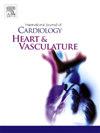Long-term cardiovascular outcomes after percutaneous coronary intervention in patients with systemic sclerosis
IF 2.5
Q2 CARDIAC & CARDIOVASCULAR SYSTEMS
引用次数: 0
Abstract
Background
Recent data have shown that systemic sclerosis (SSc) is a significant risk factor for coronary artery disease (CAD) and poorer cardiovascular outcomes in the setting of acute coronary syndrome. However, the morphological characteristics of CAD and the long-term cardiovascular outcomes in patients with concurrent SSc and CAD remain unclear.
Methods
We retrospectively investigated 3,300 patients with CAD who underwent percutaneous coronary intervention (PCI) without prior myocardial infarction or coronary artery revascularization. Laboratory, echocardiographic and angiographic characteristics, and clinical outcomes were compared between patients with and without SSc according to a 1:3 propensity score-matching analysis adjusted for patient demographics and comorbidities. The primary outcome was a composite of cardiac death, myocardial infarction, and stroke, and the secondary outcome was a composite of the primary outcome and heart failure hospitalization.
Results
Among all 3,300 patients, 17 (0.5 %) had SSc. The patients were classified into an SSc group (n = 17) and non-SSc group (n = 51) by propensity score matching. There were no significant differences in laboratory or echocardiographic parameters between the two groups. However, CAD tended to be more complex in the SSc group because of the higher proportion of left main trunk lesions (p = 0.100) and higher SYNergy between PCI with TAXUS™ and Cardiac Surgery (SYNTAX) score (p = 0.030). During a median follow-up of 3.1 years, patients with SSc more frequently experienced primary and secondary outcomes than those without SSc (both log-rank p < 0.02).
Conclusions
Among patients with CAD, long-term cardiovascular outcomes after PCI were poorer in those with than without SSc.
求助全文
约1分钟内获得全文
求助全文
来源期刊

IJC Heart and Vasculature
Medicine-Cardiology and Cardiovascular Medicine
CiteScore
4.90
自引率
10.30%
发文量
216
审稿时长
56 days
期刊介绍:
IJC Heart & Vasculature is an online-only, open-access journal dedicated to publishing original articles and reviews (also Editorials and Letters to the Editor) which report on structural and functional cardiovascular pathology, with an emphasis on imaging and disease pathophysiology. Articles must be authentic, educational, clinically relevant, and original in their content and scientific approach. IJC Heart & Vasculature requires the highest standards of scientific integrity in order to promote reliable, reproducible and verifiable research findings. All authors are advised to consult the Principles of Ethical Publishing in the International Journal of Cardiology before submitting a manuscript. Submission of a manuscript to this journal gives the publisher the right to publish that paper if it is accepted. Manuscripts may be edited to improve clarity and expression.
 求助内容:
求助内容: 应助结果提醒方式:
应助结果提醒方式:


